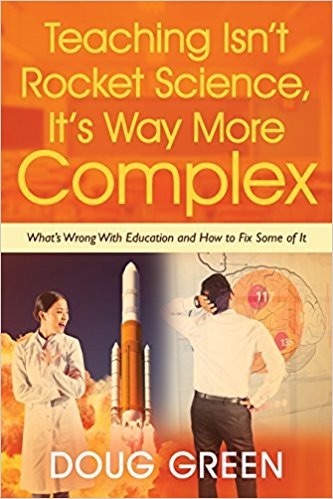Author Archive
Tuesday, July 24th, 2018

The Obvious Match: Artificial Intelligence and Education by Lora Young deals with a topic that is likely to have a profound impact on education as we move forward. Educators and parents alike should be looking for AI applications that will promote learning for all children.
Introduction
- With each year, technology seems to just keep getting better and better. As a species, we’ve always been able to survive and thrive in our environment because of our ability to innovate, create, and improve. There isn’t a single day in our lives that we aren’t using some form of technology for our benefit. There was a time when the Wright brothers were seen as crazy for thinking that it’s possible to create flying machines — today, millions of people travel by air on a daily basis.
- Modern technology has seen an increased rate of development in the past ten years. Kickstarters are popping up all around like mushrooms in a rainforest, each with their own ideas on how to make our lives much more convenient. One of these technologies is Artificial Intelligence. But…
- Artificial Intelligence? is a branch of Computer Science that aims to create machines that are able to process information and react to these pieces of information in a manner that humans would. Now you’re probably thinking: “Why would we want that?” The answer lies in one of the principles of psychology — learning. Learning is defined as the process by which experiences are able to permanently alter behavior. Now, if you really think about it, every living organism on Earth survives through the process of learning. Lions aren’t born as killing machines, nor are newborns able to speak coherently from the get-go.
- This is where learning comes in. Through experiences, which also include a wide variety of interactions, organisms are able to store information that would, in turn, alter their behavior toward a certain scenario. We know that we shouldn’t touch hot stove tops because we remember that one time we did and we ended up with 3rd-degree burns.
- Now, while a modern computer is great at performing complex calculations, it cannot alter its behavior. It is limited to user input. And while complex conditions can, in a way, simulate behavior or decision making, the computer itself cannot make sense of the experiences it encounters because these have to be manually inputted by someone else. Now, Artificial Intelligence seeks to give computers the capability to not only gather and process information but to assimilate and to act upon that information autonomously.
- This opens up a wide variety of possibilities. Because AI enables machines to adapt to situations and grow smarter over time, these machines can only become better the more than they are put to use. It is, in a metaphorical sense, the maturation of machines. Machines will soon be able to account for their experiences and future decisions will be derived from that particular experience.
How Exactly Can AI Be Used in Education?
- Because AI is able to adapt to its environment through the experiences it encounters and takes account of, AI will eventually become smart enough to determine the best course of action. Say, you’re in a Safety Training Scotland course. There are a wide variety of topics to discuss and each student has his or her own unique set of strengths and weaknesses, learning methods, language fluency levels, and cultural backgrounds. Artificial Intelligence, given enough experience, will be able to determine the best approach to each student to ensure that optimal learning is met.
- Let’s say that your main language has always been Japanese. AI will easily be able to speak and translate concepts for you because it has been exposed to different cultures. Not only that, but AI will be able to tailor your course material to match your background and your learning preferences and capabilities. It will even create meaningful representations of concepts for you and will also be able to avoid topics that may offend you in any way.
- AI can also be used in the assessment of each student’s performance, and by doing so it can alter the teaching material into something that helps students who are lagging behind catch up, and students who are performing, perform even better. There are a plethora of teaching methods that a single teacher can use, but a single teacher simply cannot teach each student according to each student’s preferred learning method. AI can do that for each student because it is capable of processing large amounts of information and determining actionable plans for each situation.
AI In Classroom Discussions
- An even greater example of AI application in education that benefits students as much as teachers is when it is used in actual classroom discussions. Regardless of what your subject matter is, classroom discussions will always have a few questions thrown about. Now, every once in a while, a student asks a question that an instructor cannot answer, or explain in a manner that students are able to digest.
- This is where AI comes in. Say, the exact scenario happened to a learning-disabled child. AI will be able to process, interpret, and present the information to the child in a manner that’s appropriate for his learning capacity, without hindering the pace of the discussion. And yes, there are always naysayers when it comes to innovation. Some people may even go as far as to say that if we decide to integrate artificial intelligence into our education systems, then what’s the point of having teachers around?
-
In Conclusion
There are even those who are extremely paranoid about technology (or they may simply have watched too many Terminator movies as a child). And while it’s uncertain when artificial intelligence will be integrated into the educational system, what’s certain is that history, especially when it concerns new technology, will always repeat itself.
- And whenever we see someone trying to create something new, we should always remember: There was a time that people thought the Wright brothers were crazy for thinking that they could create flying machines. Today, it’s commonplace.
Lora Young
- Lora was born in January 1992. Today, she is a digital marketer who has several years of experience in working with non-profit organizations. She has extensive knowledge in the fields of Education, Computer Science, and Psychology. When she isn’t helping build brands, she practices Muay Thai and runs marathons. Thanks, Lora
Posted in Guest Posts | Comments Off on The Obvious Match: Artificial Intelligence and Education by Lora Young
Friday, July 6th, 2018

The Importance of New Tech to Optimal Healthcare for Children by Rey Shimar focuses on how technology is impacting the quality of our health care. Parents should use this to look for opportunities to improve health care for their children and themselves.
Introduction
- Technology has come a long way in making life easier. From our shopping habits to planning a holiday destination, there are countless applications and software that help parents and teachers handle even the most mundane of tasks. With that being said, it shouldn’t come as a surprise to find technologies that promote better health. And as the demands for optimal health increase each year, the tech industry is investing considerably on innovation. As parents or healthcare professionals, it is always important to know about these innovations and bring out their full effectiveness.
An Environment of Innovation
- In 2018, for instance, it is expected that IT acquisitions in the healthcare industry will rise. This demonstrates the fact that both patients and medical institutions are becoming very much aware of the need for better healthcare technologies. The benefits include shorter waiting times, more accurate diagnostics, and more importantly, lower healthcare costs across.
- According to GetReferralMD.com, many of these innovations seek to streamline complex patient-physician interactions. Workflow management has to be one of the most tedious tasks that private practitioners and other healthcare professionals have to handle. With data management systems, professionals can manage their time more effectively. This will essentially improve outcomes and reduce diagnostic costs.
Keeping All Informed
- Likewise, these new healthcare innovations can also help in terms of keeping both patients and doctors informed throughout their interactions. There are mobile apps that are focused on keeping patients up-to-date with their appointments as well as helping them take medication on time. Indeed, these innovations are being adopted by independent practitioners and healthcare providers, owing to wide-ranging benefits these technologies entail. In terms of childcare, we can already sense the advantages these technologies have towards improving the mental and physical aspects of children.
Innovative Solutions for Better Childcare
- Innovations in the IT and tech sectors can improve developmental research into healthcare for children. What’s more, we can also see the positive impact they bring to both specialty and primary care, as well as localized models such as community healthcare systems which are becoming even more prominent. Along these lines, it is important for stakeholders in early childhood development to become more aware of the newest technologies that will make the experience much more rewarding.
- School administrators in particular, will have to find ways to insert technology education when it comes to training their teachers. This would involve knowing how to use apps that are specifically designed for children with disabilities or with special needs. Teachers can access educational apps that will help such students progress with the rest of the class. They can also make use of mobile guides for certain emergencies.
Posted in Guest Posts | Comments Off on The Importance of New Tech to Optimal Healthcare for Children by Rey Shimar
Tuesday, June 26th, 2018

The Obvious Match: Artificial Intelligence and Education by Lora Young posits the idea that it’s just a matter of time until artificial intelligence takes its place alongside teachers in the classroom. Her insightful post should be able to stimulate student thinking and be the basis for an engaging classroom conversation.
Introduction
- With each year, technology seems to just keep getting better and better. As a species, we’ve always been able to survive and thrive in our environment because of our ability to innovate, create, and improve. There isn’t a single day in our lives that we aren’t using some form of technology for our benefit. There was a time when the Wright brothers were seen as crazy for thinking that it’s possible to create flying machines. Today, millions of people travel by air on a daily basis.
- Modern technology has seen an increased rate of development in the past ten years. Kickstarters are popping up all around like mushrooms in a rainforest, each with their own ideas on how to make our lives much more convenient. One of these technologies is Artificial Intelligence. But…
- Artificial Intelligence is a branch of Computer Science that aims to create machines that are able to process information and react to these pieces of information in a manner that humans would. Now you’re probably thinking: “Why would we want that?” The answer lies in one of the principles of psychology — learning.
- Learning is defined as the process by which experiences are able to permanently alter behavior. Now, if you really think about it, every living organism on Earth survives through the process of learning. Lions aren’t born as killing machines, nor are newborns able to speak coherently from the get-go.
Enter Learning
- This is where learning comes in. Through experiences, which also include a wide variety of interactions, organisms are able to store information that would, in turn, alter their behavior toward a certain scenario. We know that we shouldn’t touch hot stove tops because we remember that one time we did and we ended up getting burned. Now, while a modern computer is great at performing complex calculations, it cannot alter its behavior. It is limited to user input. And while complex conditions can, in a way, simulate behavior or decision making, the computer itself cannot make sense of the experiences it encounters because these have to be manually entered by someone else.
- Now, Artificial Intelligence seeks to give computers the capability to not only gather and process information but to assimilate and to act upon that information autonomously. This opens up a wide variety of possibilities. Because AI enables machines to adapt to situations and grow smarter over time, these machines can only become better the more that they are put to use. It is, in a metaphorical sense, the maturation of machines. Machines will soon be able to account for their experiences and future decisions will be derived from that particular experience.
How Exactly Can AI Be Used in Education?
- Now, because AI is able to adapt to its environment through the experiences it encounters and takes account of, AI will eventually become smart enough to determine the best course of action. Say, you’re in a Safety Training Scotland course. There are a wide variety of topics to discuss and each student has his or her own unique set of strengths and weaknesses, learning methods, language fluency levels, and cultural backgrounds. Artificial Intelligence, given enough experience, will be able to determine the best approach to each student to ensure that optimal learning is met.
Adapting to Each Learner
- Let’s say that your main language has always been Japanese. AI will easily be able to speak and translate concepts for you because it has been exposed to different cultures. Not only that, but AI will be able to tailor your course material to match your background and your learning preferences and capabilities. It will even create meaningful representations of concepts for you and will also be able to avoid topics that may offend you in any way.
- AI can also be used in the assessment of each student’s performance, and by doing so it can alter the teaching material into something that helps students who are lagging behind catch up, and students who are performing, perform even better. There are a plethora of teaching methods that a single teacher can use, but a single teacher simply cannot teach each student according to each student’s preferred learning method.
Final Thoughts
- AI can do that for each student because it is capable of processing large amounts of information and determining actionable plans for each situation. An even greater example of AI application in education that benefits students as much as teachers is when it is used in actual classroom discussions. Regardless of what your subject matter is, classroom discussions will always have a few questions thrown about. Now, every once in a while, a student asks a question that an instructor cannot answer, or explain in a manner that students are able to digest.
- This is where AI comes in. Say, the exact scenario happened to a learning-disabled child. AI will be able to process, interpret, and present the information to the child in a manner that’s appropriate for his learning capacity, without hindering the pace of the discussion. And yes, there are always naysayers when it comes to innovation. Some people may even go as far as to say that if we decide to integrate artificial intelligence into our education systems, then what’s the point of having teachers around? There are even those who are extremely paranoid about technology (or they may simply have watched too many Terminator movies as a child). And while it’s uncertain when artificial intelligence will be integrated into the educational system, what’s certain is that history, especially when it concerns new technology, will always repeat itself.
- And whenever we see someone trying to create something new, we should always remember: There was a time that people thought the Wright brothers were crazy for thinking that they could create flying machines. Today, they are commonplace.
Lora Young
- Lora was born in January 1992. Today, she is a digital marketer who has several years of experience in working with non-profit organizations. She has extensive knowledge in the fields of Education, Computer Science, and Psychology. When she isn’t helping build brands, she practices Muay Thai and runs marathons. If you are looking for someone that can write high quality copy you can contact her at . You can follow her on Twitter at @TheamazingLORA.
Posted in Guest Posts | Comments Off on The Obvious Match: Artificial Intelligence and Education by Lora Young
Tuesday, June 12th, 2018
My informal research has found that many if not most students lack serious interests let along a passion for anything worthy of academic effort. When I ask students what they are interested in or what they want to major in someday, I often get little more than a shrug. So what should we do?
What My Blogging Effort Reveals
- Every day I surf the Internet searching for resources for my audience of parents and educators. I have found a number of themes that show up often. These themes form the basis of my recent book Teaching Isn’t Rocket Science, It’s Way More Complex: What’s Wrong With Education and How to Fix Some of It. (Purchase at Amazon — Executive summary) In it I deal with themes like the importance of relationships, personalizing instruction, and the harm caused by standardized testing.
So what should we do?
- One reoccurring theme is that teachers should allow students time to pursue their interests and passions rather than being forced to only study the school’s standard curriculum. I like this idea. In some schools, students are allowed to study what they want on a regular basis. This resembles Google’s 20% time where employees can do what they want one day each week and let everyone know what they accomplish. Other schools weave student interests and passions into project-based learning.
Most Lack Passion
- While this sounds good, my informal research has found that many if not most students lack serious interests let along a passion for anything worthy of academic effort. When I ask students what they are interested in or what they want to major in someday, I often get little more than a shrug. I don’t count passions for things like social media or computer games as topics that we should turn students lose to study in school, although I’m sure creative teachers can work them in somehow.
Convince the Teachers
- We need to convince teachers that it’s important for students to find interests and passions about topics that could lead towards a career. The next step is to suggest ways they can help students find their passion as part of their current teaching practice. I don’t think this should be too difficult. Regardless of what one teaches, one can make an effort to simply expose students to as many potentially interesting aspects of their discipline as possible.
Be Direct
- Tell students directly that it is their job to find things they are interested in as they encounter new things anywhere and to make notes of what they find attractive. They should turn in a list of things that they would like to explore further. The teacher then carves out time for individual exploration that can be online and hands on. Students need to be responsible for reporting on what they find.
Put Student Work On a Blog
- A classroom blog can help. With help from the school IT staff it should be easy for students to post their work. Once posted, the teacher, their classmates, and parents can see evidence of growing passions. Students should be allowed to continue with a subject of interest or to explore something else. This seems possible and I believe that it would serve the students well and accomplish the vision of many people with strong expertise in the field of education.
Who is Dr. Doug Green
- Doug has been an educator since 1970. After teaching chemistry, physics, and computer science, he became an administrator for the next 30 years with experience at the secondary, central office, and elementary levels. He has also taught a number of leadership courses for The State University of New York at Cortland and Binghamton University and authored over 300 articles in computer magazines and educational journals. In 2006 he gave up his job as an elementary principal to care for his wife who had Lou Gehrig’s disease. After her death in March of 2009 he decided to see how I could use my expertise to help busy educators and parents hone their skills and knowledge and started this blog.
Posted in Doug's Original Work | Comments Off on If Supporting Student Passion Is So Important, What If They Don’t Have Any?
Tuesday, June 5th, 2018
How To Bake ∏: An Edible Exploration of the Mathematics of Mathematics by Eugenia Cheng uses classic baking recipes to illuminate many math concepts. It helps take math into the real world as it helps to make some math seem easier to its readers. At the very least, it should find its way into the hands of every math teacher and serious math students.
Part I: Math – 1. What Is Math?
- Like all chapters this one starts with a recipe since like recipes math has both ingredients and methods. In math, however, the method being used is probably more important than the ingredients. Once you find a technique in math you can always find more things to study with it. The two key concepts here are abstraction and generalization. Math is abstract in that it studies ideas of things, rather than real things. The invention of numbers to represent things was perhaps the first-ever process of abstraction.
2. Abstraction
- To do math you have to step away from reality. This is where math finds its strength. The idea that two things cost twice as much as one thing applies to all things, for example. Here we have a process that generalizes. Maps are abstractions of reality. The key for map makers is to find the most appropriate level of abstraction for the given moment. There are a number of math problems here that show how procedures work regardless of the specific numbers involved.
3. Principals
- When making any recipe, it helps to understand the principals of the ingredients and finished products you are working on. Understanding the principles allows you to take shortcuts and substitute ingredients without ruining everything. Recipe books, however, rarely explain such principles. Understanding is power in cooking and in math. At the heart of math is the desire to understand things rather than just knowing them. The chapter goes on to spell out the principals for the natural numbers we use for counting.
4. Process
- Flour, butter, water, and salt can make a delicious puff pastry, but only if you follow a specific method. Math requires the proper method also and further requires that almost nothing is basic or given. The rules of logic must be followed. Eugenia shows how you can make two mistakes in math and still get the correct answer. At the heart of math is the need to understand things rather than just knowing them. In other words, the means justifies the end.
Posted in Book Summaries, Education Books, Leadership Books | Comments Off on How To Bake ∏: An Edible Exploration of the Mathematics of Mathematics by Eugenia Cheng










